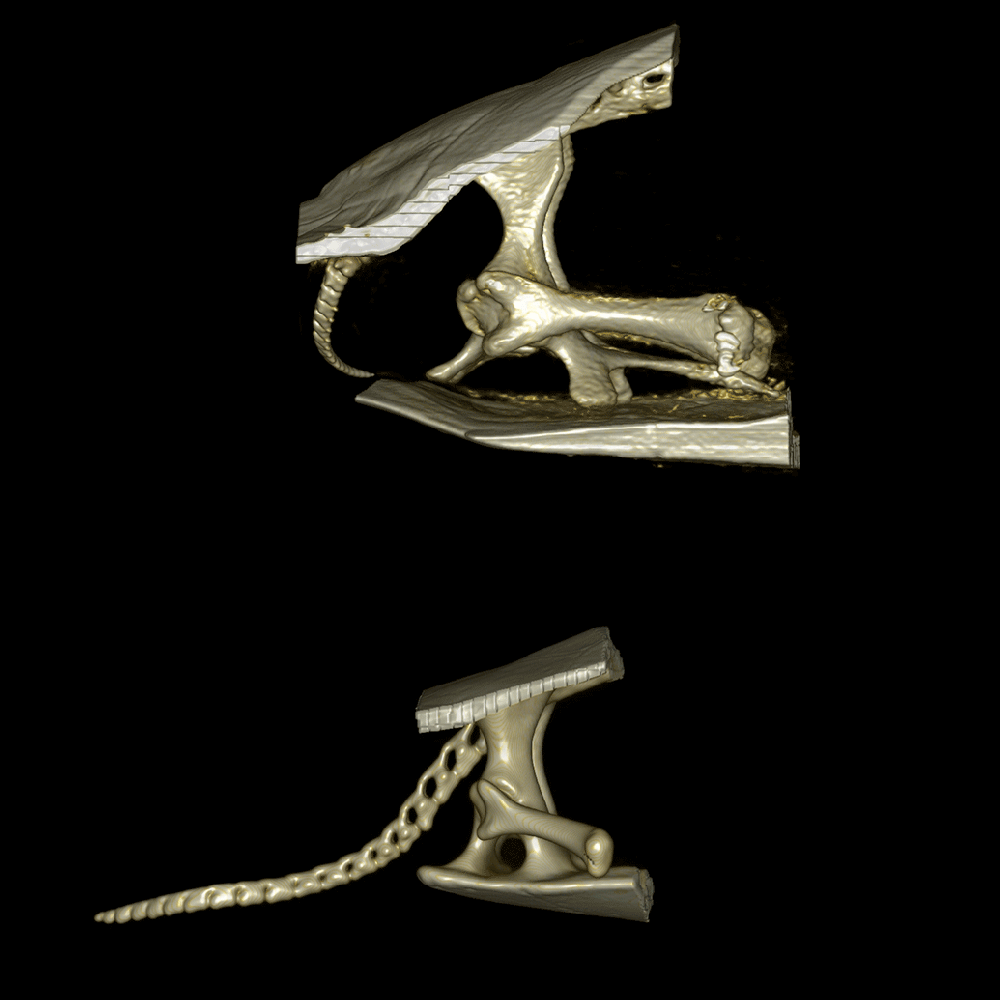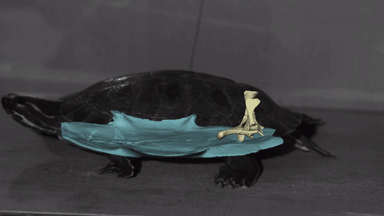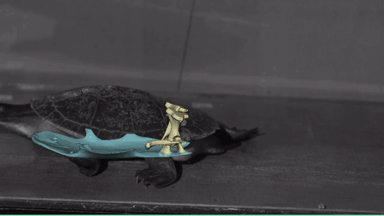by Christopher Mayerl, Evolutionary Morphology and Biomechanics Laboratory at Clemson University (S. Carolina, USA). If you would like to contribute a guest post, please get in touch, such as on Twitter or Facebook.
When you see a turtle, you automatically know it’s a turtle and not something else, probably because of its distinctive shell. However, there’s actually quite a lot of variation within turtles inside of that shell. There are two extant (or living) groups of turtles: the pleurodires and the cryptodires (Fig. 1). These two groups can be distinguished by a variety of physical characteristics, but one feature that distinguishes them that has received relatively little attention, is their different pelvic girdle (hip region) morphologies.
 Fig. 1. Representative aquatic cryptodire (Sternotherus odoratus) and pleurodire (Emydura subglobosa) turtles.
Fig. 1. Representative aquatic cryptodire (Sternotherus odoratus) and pleurodire (Emydura subglobosa) turtles.
Like all tetrapods (four-limbed vertebrates), turtles have a pelvis that is made up of three bones that have fused together (the pubis, ischium, and ilium). In most tetrapods, the pelvis swings back and forth as the animal moves its legs – go ahead and walk around for a bit, paying attention to your hips swaying back and forth with each step. This rotation in synchrony with leg movements allows animals to take larger steps. Longer steps means faster movement. That’s usually a good thing, not just for humans, but also for other animals that rely on being fast in order to capture prey and evade predators.
In cryptodire turtles, the pelvic girdle’s morphology looks pretty similar to your typical tetrapod’s – the ilium attaches to the sacral vertebrae (lower backbone), and the pelvis just sort of hangs out as a place where the leg meets the rest of the body. This was the standard condition for turtles throughout their evolutionary history – a pelvis that is unattached to the shell. Pleurodires, however, have a specialized pelvic girdle morphology in which the pelvis has fused to the shell, both dorsally to the top of the shell (the carapace) and ventrally to the bottom of the shell (the plastron) (Movie 1).
 Movie 1. CT scans of the pelvic girdle and femur of a cryptodire (top, Pseudemys concinna) and pleurodire (bottom, Emydura subglobosa) turtle. In cryptodires, the pubis and ischium (projections of the pelvis towards the plastron) appear to be floating in space, and the ilium (where the pelvis contacts the shell at the carapace) is in contact via a joint. This is in contrast to the pleurodire condition, in which the pelvis has fused to the shell.
Movie 1. CT scans of the pelvic girdle and femur of a cryptodire (top, Pseudemys concinna) and pleurodire (bottom, Emydura subglobosa) turtle. In cryptodires, the pubis and ischium (projections of the pelvis towards the plastron) appear to be floating in space, and the ilium (where the pelvis contacts the shell at the carapace) is in contact via a joint. This is in contrast to the pleurodire condition, in which the pelvis has fused to the shell.
My colleagues and I at Clemson University and Brown University wanted to know if this difference in pelvic girdle morphology corresponded with a difference in mobility. Normally, when researchers want to know how animals move, they investigate by collecting and analyzing high speed videos of the animals moving. We couldn’t follow those standard procedures to see how the pelvis of a turtle might be moving because it is hidden inside of that distinctive feature, the shell. In order to be able to see how the pelvic girdle moved in pleurodires and cryptodires, we had to use a technology called X-Ray Reconstruction of Moving Morphology (XROMM). This is a relatively recent technology in which CT scans (like the ones you see above) are combined with high speed X-Ray video in order to visualize how the skeleton moves in animals. After we finished filming our turtles with X-Rays, we matched up the movements we observed in the animal with the CT scans in order to reconstruct how their pelvis moved in 3-D while walking and swimming.
We found that the difference in pelvic girdle morphology between cryptodires and pleurodires really did result in changes in mobility. The cryptodire’s pelvis rotated by approximately 20 degrees with every step, much like the pelvis does in a lizard or other tetrapod, but the pleurodire’s pelvis remained completely immobile during locomotion. Not only was the movement of the cryptodire pelvis inside of the shell a complete surprise to all of us, but it also means that pleurodire turtles can’t take advantage of pelvic girdle rotations to improve their walking performance. (Movie 2, and link to our paper).

 Movie 2. Pelvic girdle movements while walking are much greater in cryptodire (top) turtles than they are in pleurodire (bottom) turtles. The plastron is the blue-green sheet of bone along the belly.
Movie 2. Pelvic girdle movements while walking are much greater in cryptodire (top) turtles than they are in pleurodire (bottom) turtles. The plastron is the blue-green sheet of bone along the belly.
By embracing new and exciting ways to understand how animal anatomy relates to the actions that they can take, we’re starting to build a picture of the consequences of having a fused pelvis. Fusion of the pelvis to the shell in pleurodire turtles seems to have eliminated the very common pelvic girdle movements that we see in most other tetrapods. What prompted the evolution of this novel feature, and what are the consequences for the animals that possess it? We’re taking steps to understand those types of questions now, so stay tuned for more!
One Comment Add yours